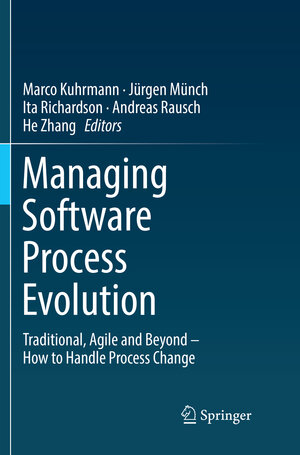
“This book focuses on the evolution of software processes and presents different aspects of it, including design, development, management, governance, and application. … I enjoyed reading this book. It is well structured and well balanced around applicability to industry, industrial experience, and academic rigor. … A practitioner will enjoy the range of presented topics. … I truly enjoyed reading the book.” (Alexandre Bergel, Computing Reviews, April, 2017)
Managing Software Process Evolution
Traditional, Agile and Beyond – How to Handle Process Change
herausgegeben von Marco Kuhrmann, Jürgen Münch, Ita Richardson, Andreas Rausch und He ZhangThis book focuses on the design, development, management, governance and application of evolving software processes that are aligned with changing business objectives, such as expansion to new domains or shifting to global production. In the context of an evolving business world, it examines the complete software process lifecycle, from the initial definition of a product to its systematic improvement. In doing so, it addresses difficult problems, such as how to implement processes in highly regulated domains or where to find a suitable notation system for documenting processes, and provides essential insights and tips to help readers manage process evolutions. And last but not least, it provides a wealth of examples and cases on how to deal with software evolution in practice.
Reflecting these topics, the book is divided into three parts. Part 1 focuses on software business transformation and addresses the questions of which process(es) to use and adapt, and how to organizeprocess improvement programs. Subsequently, Part 2 mainly addresses process modeling. Lastly, Part 3 collects concrete approaches, experiences, and recommendations that can help to improve software processes, with a particular focus on specific lifecycle phases.
This book is aimed at anyone interested in understanding and optimizing software development tasks at their organization. While the experiences and ideas presented will be useful for both those readers who are unfamiliar with software process improvement and want to get an overview of the different aspects of the topic, and for those who are experts with many years of experience, it particularly targets the needs of researchers and Ph. D. students in the area of software and systems engineering or information systems who study advanced topics concerning the organization and management of (software development) projects and process improvements projects.



